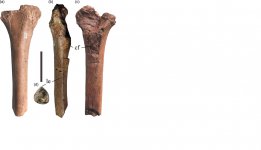Fred Ruhe
Well-known member

Eric Buffetaut and Dephine Angst, 2021
Macrornis tanaupus Seeley, 1866: an enigmatic giant bird from the upper Eocene of England
Geological Magazine. in press
doi:10.1017/S0016756820001466
Abstract: https://www.cambridge.org/core/jour...e-of-england/644A645383E9E2BD2B5DD1654AE3FD30
A large bone from the upper Eocene Totland Bay Formation of Hordle Cliff (Hampshire), originally described by Seeley (1866) as Macrornis tanaupus and interpreted by him as belonging to a ‘large Struthious bird’, is redescribed and illustrated for the first time. It is not a reptile bone, as previously suggested, but the proximal part of a left avian tibiotarsus. A mass estimate of 43 kg, comparable to that of an emu, suggests that it was flightless. A precise identification is difficult because of the incompleteness of the specimen, and Macrornis tanaupus should probably be considered as a nomen dubium. We exclude Seeley’s interpretation as a ratite, as well as previous attributions to gastornithids. We tentatively suggest that the specimen may belong to a phorusrhacid, which would extend the stratigraphic record of this group in Europe by a few million years. The presence of a large terrestrial bird in the upper Eocene of Europe may have a bearing on the interpretation of enigmatic footprints of very large birds from the upper Eocene Paris gypsum.
Enjoy,
Fred
Macrornis tanaupus Seeley, 1866: an enigmatic giant bird from the upper Eocene of England
Geological Magazine. in press
doi:10.1017/S0016756820001466
Abstract: https://www.cambridge.org/core/jour...e-of-england/644A645383E9E2BD2B5DD1654AE3FD30
A large bone from the upper Eocene Totland Bay Formation of Hordle Cliff (Hampshire), originally described by Seeley (1866) as Macrornis tanaupus and interpreted by him as belonging to a ‘large Struthious bird’, is redescribed and illustrated for the first time. It is not a reptile bone, as previously suggested, but the proximal part of a left avian tibiotarsus. A mass estimate of 43 kg, comparable to that of an emu, suggests that it was flightless. A precise identification is difficult because of the incompleteness of the specimen, and Macrornis tanaupus should probably be considered as a nomen dubium. We exclude Seeley’s interpretation as a ratite, as well as previous attributions to gastornithids. We tentatively suggest that the specimen may belong to a phorusrhacid, which would extend the stratigraphic record of this group in Europe by a few million years. The presence of a large terrestrial bird in the upper Eocene of Europe may have a bearing on the interpretation of enigmatic footprints of very large birds from the upper Eocene Paris gypsum.
Enjoy,
Fred




